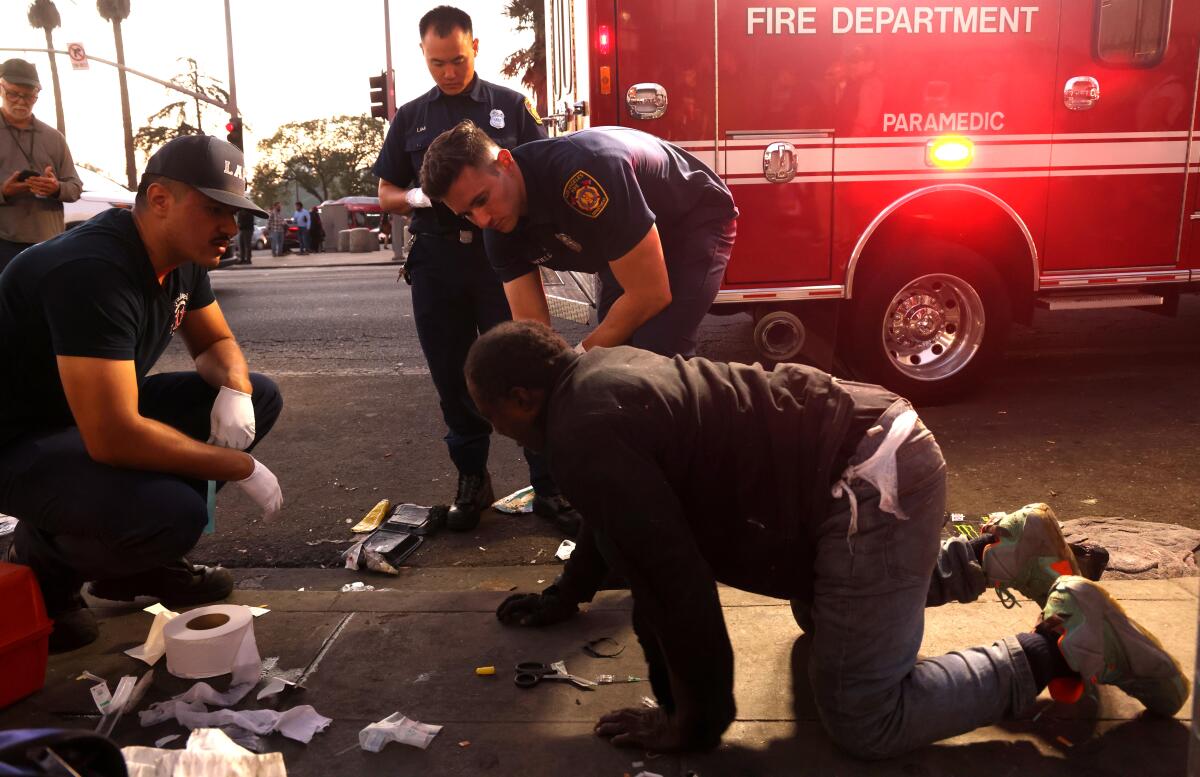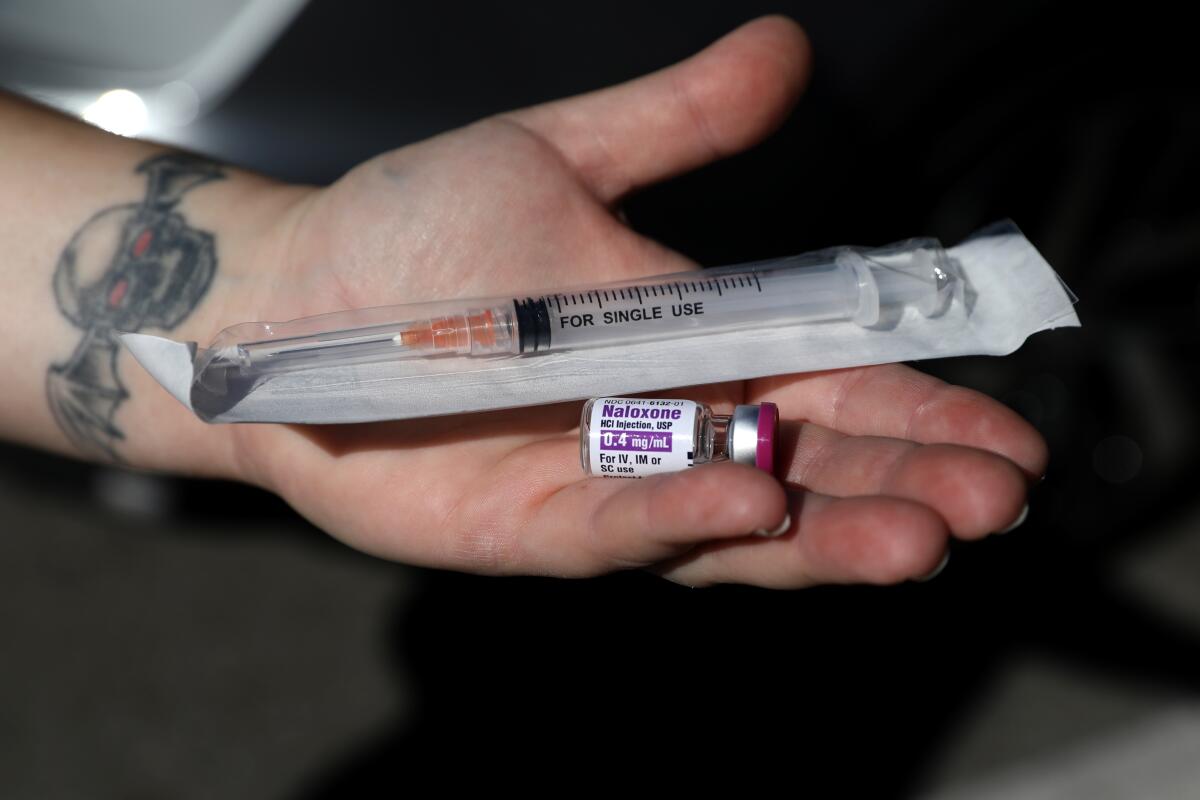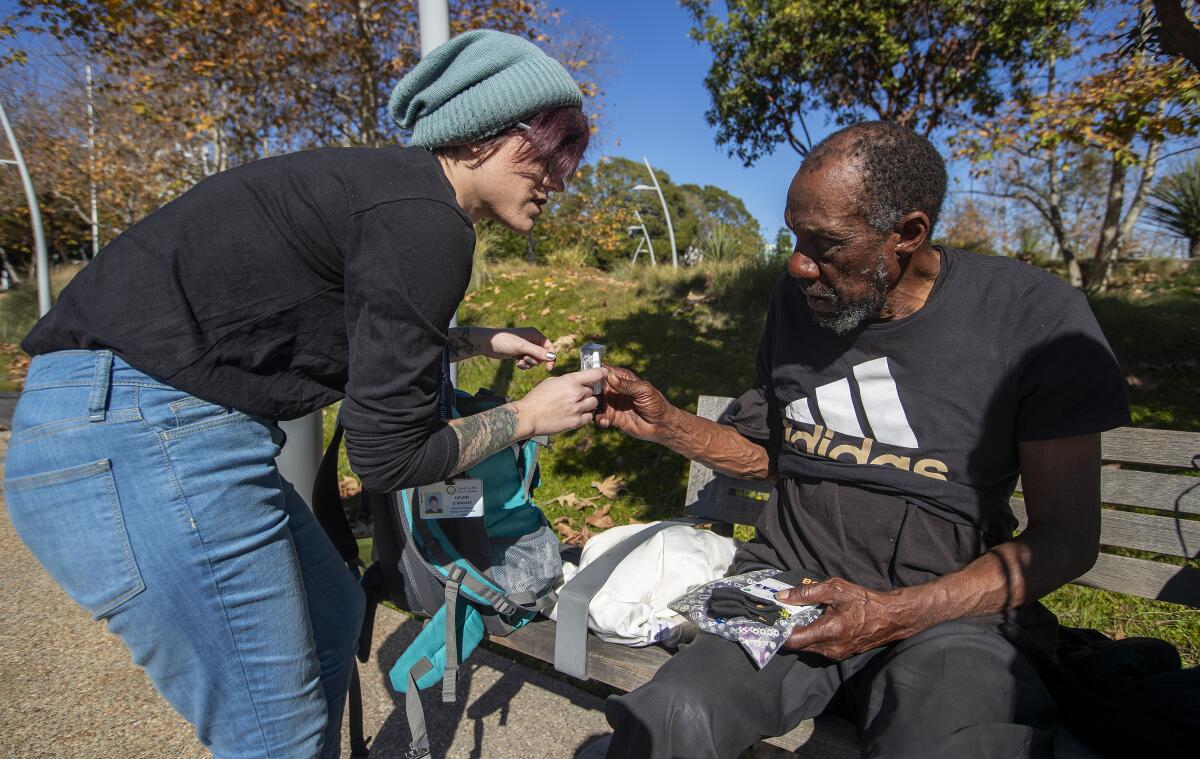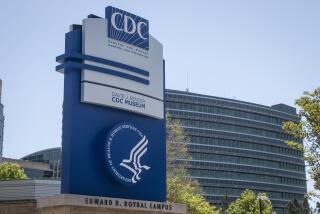‘Now is not the time’: Trump cuts to L.A. overdose prevention efforts alarm experts

- Share via
Nearly a decade into California’s fentanyl crisis, public health experts are finding cause for both optimism and worry.
Fatal opioid overdoses in the state have finally receded from record highs, with around 6,700 deaths recorded in the first half of 2024 — a roughly 16% drop from 2023’s peak.
But doctors, researchers and some L.A. County officials warn that many key measures credited with turning the tide are in jeopardy. President Trump has slashed federal funding for addiction treatment programs, with some services in L.A. County on the chopping block.
Preliminary L.A. County data show around 1,300 fatal overdoses caused by fentanyl and other opioids through mid-2024, around 300 fewer deaths compared to a similar time in 2023.
Several experts said an emphasis on harm reduction, including increased availability of the overdose reversal drug naloxone and fentanyl testing kits, was behind the improvement.
But money earmarked to support such efforts is now drying up.
Programs that offer services to support drug users and decrease overdose deaths worry the Trump administration’s sweeping federal overhaul will have far-reaching ramifications for their work.
An L.A. County Public Health Department spokesperson said the federal cuts included rescinding more than $45 million in harm reduction grants. Some funding for substance abuse prevention was also terminated mid-contract due to the federal budget changes, the spokesperson said.
“Just as we’re making progress on overdose numbers, now is not the time to divest,” the Public Health Department’s statement said.
At the same time, local authorities are re-embracing a more traditional approach to fighting crime, which includes pursuing longer prison sentences against some drug offenders.
President Trump has designated cartels as terrorist groups and called for the death penalty against fentanyl dealers. His approach has been welcomed by some parents who have lost children to overdoses, but others warn of added stigma and unintended consequences.
Californians voted to pass Proposition 36 during the last election cycle, imposing stricter penalties for repeat theft and crimes involving fentanyl.
L.A. County Dist. Atty. Nathan Hochman campaigned last year on the drug crisis, pledging to hold “fentanyl poisoners/murderers fully accountable for their actions of spreading this poison throughout our communities.”
“Every fentanyl dealer will be warned of the severe repercussions to their liberty if they kill a person with their poison,” Hochman’s campaign website said.

Ricardo Garcia, L.A. County’s public defender, said the renewed emphasis on punishment for drug crimes feels like a flashback to when lengthy sentences for crack fueled mass incarceration.
“It’s something that we’ve seen before that rises very quickly and often has a devastating effect on poor communities, Black and brown communities, and quite frankly, taxpayers, as the cost of dealing with this over-policing,” Garcia said.
The parallels to the crack era are troubling to many working on the front lines of today’s crisis, from dehumanizing rhetoric — describing fentanyl users as “zombies” — to punitive sentencing policies.
Sabrina De La Peña alleges she was sexually assaulted, beaten with a skateboard and pepper-sprayed over the course of two weeks in April at the Westlake convenience store she has run for nearly 30 years.
Shoshanna Scholar, director of harm reduction for L.A. County, said the key to saving lives is clear: Ramp up naloxone distribution and overdose prevention efforts in high-risk communities.
“Over the last 25 years, there’s been a real reckoning with substance use and seeing it as a chronic condition, as opposed to bad behavior that requires punishment in order to change it,” Scholar said. “We know there’s another path and it actually works to reduce the number of dead people.”
Since 2023, California Gov. Gavin Newsom has invested over $1 billion in grants for naloxone distribution, fentanyl test strips and other anti-overdose initiatives. Naloxone — also known as Narcan — is now available for purchase for all California residents through the CalRx initiative for $24.
At this year’s Coachella Valley Music and Arts Festival, End Overdose, a Burbank-based organization, had a booth near the festival’s EDM stages offering naloxone training, free doses and a variety of swag.
At the stall, two twentysomething festivalgoers, Mimi and Lily — who asked to be identified only by their first names to discuss drug use — said they had been taking every possible precaution for fear they could be sold something laced with fentanyl.
“Honestly, we learn the most from Reddit and from our parents. They are always telling me to be careful about fentanyl,” said Mimi. “It reminds me a lot of when people promote abstinence when it comes to safe sex, when they really should be talking about condoms and birth control. Because, either way, people are going to do drugs, so you have to make sure you are doing it safely.”
Dr. Brian Hurley, the county’s medical director who oversees addiction treatment initiatives, said implementing harsher penalties on drug users can increase the risk of overdose, as people are more likely to use alone and in secret.
“It becomes harder to engage people in an open, honest, neutral conversation about if they are ready to stop using, if they are ready to try interim housing or take a shelter bed. All of these things get people off the street in a way that advances what I think most people really want,” Hurley said.
He and others noted that even with the tough-on-crime policies of the 1980s and ’90s, crack cocaine use has never gone away. And despite local authorities saying for years that arrests and prosecutions alone are not the solution, experts said it’s still difficult for those in need of treatment to find help.

“People are pushing more severe penalties and more arrests, but it’s just that’s not how you stop people from using a drug you don’t want them to use,” said Dr. Ricky Bluthenthal, a public health professor at USC. “Generally speaking, incarceration isn’t a place where people get better.”
That message, however, runs contrary to the hard-line approach now being pushed by the White House. Trump has cited fentanyl deaths as a reason for tariffs against China, a source of chemical ingredients used in clandestine labs, and suggested drone strikes on Mexican drug cartels. Trump has also declared fentanyl a weapon of mass destruction and called for giving drug dealers the death penalty
Mexican President Claudia Sheinbaum said she rejected an offer by President Trump to send U.S. troops to fight Mexican drug cartels.
For Dr. Daniel Ciccarone, a UC San Francisco professor who researches public health and drug use, it’s hard not to see history repeating itself.
The professor, who recently published a paper about “moral panics” surrounding drug use, said elected officials have long been more concerned with optics and approval ratings than addressing the underlying causes of addiction.
“We’re afraid of this drug, and we’re afraid of people who use the drug,” Ciccarone said. “When we get fearful, the natural human response is to look for security. Who can make us feel more secure? The police and courts.”
The recent trend in overdose deaths at least offers a glimmer of hope, he added, even if no one can agree on the best path forward.
“I recognize that as a human impulse of fear, urgency and panic, that we must do something,” he said. “I’ve heard this from the police saying, ‘We have to be seen as doing something,’ and I say, ‘OK, but don’t make the problem worse.’”
More to Read
Sign up for Essential California
The most important California stories and recommendations in your inbox every morning.
You may occasionally receive promotional content from the Los Angeles Times.















